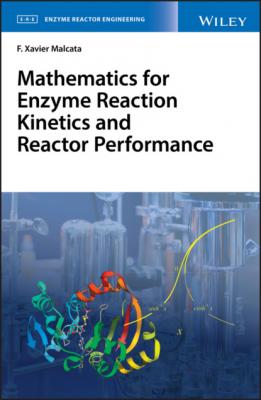Mathematics for Enzyme Reaction Kinetics and Reactor Performance. F. Xavier Malcata
Читать онлайн.| Название | Mathematics for Enzyme Reaction Kinetics and Reactor Performance |
|---|---|
| Автор произведения | F. Xavier Malcata |
| Жанр | Химия |
| Серия | |
| Издательство | Химия |
| Год выпуска | 0 |
| isbn | 9781119490333 |
note that both
(2.197)
In view of Eq. (2.159), r1 being a root of Y<m supports
(2.198)
where ς<m‐1{x} denotes an (m − 1)th degree polynomial of x; insertion in Eq. (2.193) unfolds
Equation (2.199) degenerates to
after dropping x − r1 from both numerator and denominator of the first term in the right‐hand side; ς<m−1/
with Α1,2 denoting a second constant to be replaced by
(2.202)
in parallel to Eq. (2.196) obtained from Eq. (2.193); insertion of Eq. (2.201) transforms Eq. (2.200) to
(2.203)
as long as
(2.204)
The same rationale may then be applied to the second root r2, of multiplicity s2, and so on, until one gets
therefore, any proper rational fraction with poles r1, r2, …, rs (or r, for short) of multiplicity s1, s2, …, ss, respectively (or s for short), may be expanded as a sum of partial fractions bearing a constant in numerator, as well as x − r, (x − r)2, …, (x − r)s sequentially in denominator – irrespective of the mathematical nature of such roots.
To avoid emergence of complex numbers – and taking advantage of the fact that if a polynomial with real coefficients has complex roots then they always appear as conjugate pairs (otherwise its coefficients would necessarily be complex numbers), one may lump pairs of complex partial fractions as
(2.206)
upon elimination of parentheses in numerator, and rearrangement of inner parentheses in denominator, one gets
After condensation of terms alike in numerator, and recalling Eq. (2.140), i.e. the product of two conjugate binomials equals the difference of their squares, Eq. (2.207) becomes
since, by definition, ι2 = −1, one may simplify Eq. (2.208) to
Once the square of the binomial in denominator is expanded as per Newton’s rule, Eq. (2.209) becomes
(2.210)
which may be rewritten as
(2.211)
the new constants are defined as
(2.212)
